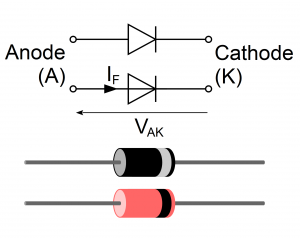Learning Circuitry Part 1: Breaking Down The Absolute Basics
It’s hard to go anywhere and not notice the marvels of Electrical Engineering.
Even your favorite remote vacation spot will have a power line running through it! But today, we’re not here to talk about the big inventions that truly put us on the road to revolution.
Instead, this article will focus on basic electrical circuits that form the basis of all electronic devices, ranging from full blown generators to micro-processors.
Table of contents
Introduction:
Diving right into devices like Radio transmitters, microcontrollers, robotics, etc. sounds very fascinating but it would be an impossible task if you have incomplete knowledge about the building blocks of electronic circuits.
Circuits have been around ever since the discovery of electric current and ever since then millions of types of circuits have been developed.
But each circuit when broken down turns out to be a combination of the right components for the task, that’s it.
The simplest of all circuits is a one that lights up a lamp (or in most cases an LED). Take a look:

How does it work? When the switch closes, a closed path forms triggering the lamp to glow. On the other hand, when the switch opens, the path breaks and the lamp stops glowing.
There are three parameters you must be aware of when dealing with circuits:
They are:
- Voltage,
- Current,
- Resistance
First of all, think of the current as the actual flow of electrons through the cable. The electrons “propagate” from the positive end of the battery (longer side) by a force proportional to the “voltage” and pass through the Lamp.
The energy of the electrons dissipate in the lamp in some manner which may be heat or light. From there, the electrons travel to the negative end of the battery and the cycle repeats.
This was a bit theoretical but nonetheless important to understand.
There are three major components that a beginner must learn in circuitry.
They are:
- Resistor,
- Capacitor,
- Inductor,
Surely, they’re advanced in design, but their purpose & principle remains the same.
Now, ever since the development of semiconductor components, notably the “transistor”, the world of electronics has changed.
Their invention made it possible for the size of devices to decrease several folds, primarily the computer which used to occupy rooms!
Two major semiconductor components whose knowledge is must-have are:
- Transistor,
- Diode,
![]() How are circuits made? The first and most simple way is connecting your components using a piece of actual wire.
How are circuits made? The first and most simple way is connecting your components using a piece of actual wire.
But this isn’t how the mass-produced real world works. If you’ve ever opened your desktop computer, LCD, mobile phone or any electronic component you would’ve noticed a brown/green/red “board” that has all the components etched into it. That “board” is knowns as a PCB or Printed Circuit Board.
A PCB is made out of copper, aluminum or any other conductor and covered with an insulator. A PCB may be single layered for simple electronic products or multiple layered for graphics cards, motherboards, etc.
Coming back to the components that actually make up a circuit, developing your own circuit is one of the most fun jobs on the planet, especially when you know what each component at your disposal does.
You can make a number of useful circuits for your own use like water level detectors, radio wave transmitters, etc. and can learn a great deal as you develop.
However, before you can do so, you must know what each component is and how it works.
![]()
Resistors
![]() Easily, the most popular component in the world of circuits.
Easily, the most popular component in the world of circuits.
A resistor’s job is simple, i.e. to dissipate energy. Its unit is Ohms, represented by an Omega symbol.
The higher the resistance, the more hurdles it will create for the flow of current and the more heat it will give off.
Note, every component or conductor in the world has some inner resistance. However, special resistors are manufactured because of the need to intentionally bring down voltage.
One of the most useful application of resistors is in electric heaters where the goal is to generate maximum heat energy utilizing electric current.
When you go to an electronics Store to buy resistors, you’ll need to know how to determine the resistance through color-coding. Here’s a chart that will help you:
![]()
Capacitors
A battery is not the only thing that can store energy. Electrical energy can be stored in the form of static field in capacitors.
They can’t store this energy for long and don’t have that much of a capacity but their ability to resist change in voltage due to any circumstance makes them an asset to every circuit.
A capacitor is simple made up of two conducting plates with an insulator in between called the dielectric. The properties of the dielectric and the surface area of the insulator are the main players in tweaking the value of capacitance.
![]()
The units of capacitance is a farad which is a large unit in itself. Common capacitors are microfarads or even smaller.
Modern day electronics makes extensive use of capacitors as they can smooth-out uneven voltage levels.
![]()
Inductors
An inductor is a device similar to a capacitor in many ways. It also stores energy but in the form of a magnetic field.
You can make the simplest of inductors yourself by forming a loop or coil of magnetic wire.
However, you must know that fabrication of inductors for electronic devices is one of the most trivial processes in the world and must be carried out with extra care.
The requirement for inductors is usually specific so most of the time you’ll need to either enter into a compromise over its commercially available unit or have a special one made for you.
Inductor fabrication is becoming quite common and you can easily get a custom one from the market from a proper electronic store.
A dielectric may be air-cored or use a ferromagnetic material as its dielectric.
The unit for inductors is in henries, but mostly inductors used are in the order of micro or sometimes milli.
Inductors can be used to smooth out currents and are used in communications circuits.
![]()
Transistors
The transistor is a component that has truly revolutionized the electronics industry. Invented in 1947 and refined in the 60s, transistors literally compressed the size of devices that were previously the size of rooms.
The use of semiconductors really pushed the entire process and gave way to components that define modern electronics.
In addition to transistors, other semi-conductor devices include thyrister, diodes, and op-amps. However, most of these components which are used to make complex devices are derivatives of transistors.
In a nutshell, a transistor is a switch that can be controlled electrically.
It has 3 terminals namely the base, collector and emitter. The names vary for different types of transistors but the concept remains the same.

When voltage is applied at the base terminal of the transistor, it acts as a gateway and allows the flow of charge from collector to emitter or emitter to collector, depending on its type.
A few types of transistors are:
– Bipolar Junction Transistor
– Field Effect Transistor
– Metal oxide semiconductor field effect transistor (best)
Transistors are the basic elements that form complex circuits like logic gates, thyristors, and amplifiers. The list is endless.
![]()
Diodes
A diode is another semi-conductor device but unlike a transistor it has only two terminals, i.e. anode and cathode. It may be thought of as the simplest semi-conductor component, used primarily as rectifiers (i.e. an AC–DC converter.)
The fundamental property of diodes are that they only conduct in one direction, anode to cathode.
They have a small voltage barrier which must be met to start the flow of current called the threshold voltage, after which they act as short circuit wires.
Thus, you may think of a diode as a switch controlled by its threshold voltage, with a very small resistance.

There have been a great number of developments & breakthroughs with diodes.
Diodes may have a limited usage compared to the other components but their principle has been used for components like the thyristor, whose open/close nature can be controlled via a third terminal.
In addition, there are several types of diodes, e.g. Light emitting diodes which give off light, photodiode which can detect light, Zener diodes which work in the opposite manner, etc.
Final Notes
This was a basic overview of circuits and the basic components used in their development.
Hope you enjoyed it! The main objective of this article was to get you introduced to the science behind circuitry to help you better understand what different components do when you’re building MIDI controllers.
There’s more to come, so stay tuned!
Leave a Comment
4 comments
This is the beginning of what is becoming an excellent series of articles; I can forsee directing many people to your site for knowledge and resources.
Thanks much!
Love reading comments like that 🙂 Appreciate it!
I already tried to read on the subject, nothing ever works for people like me, who need to understand the basic functioning of things just to remember them. Thank you so much! I knew it was simple, but nobody was willing to explain. Now I’ll be waiting to read more of this.
Glad you enjoyed it, Claude! More to come soon:)